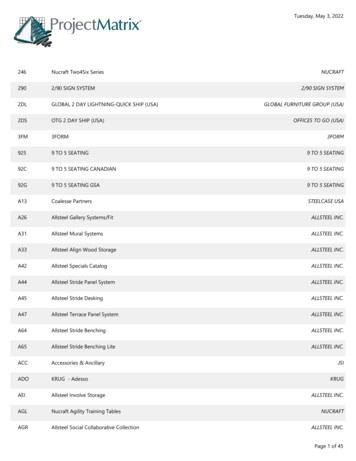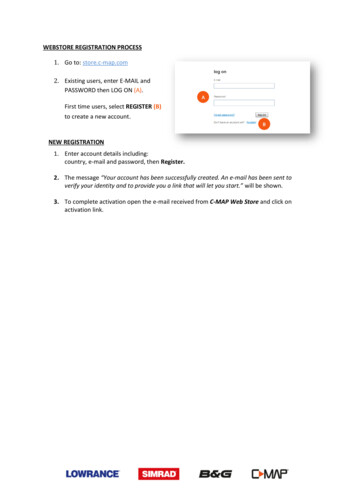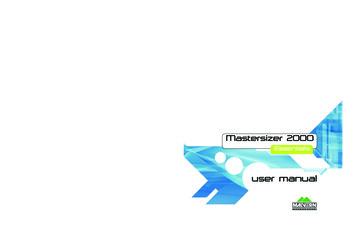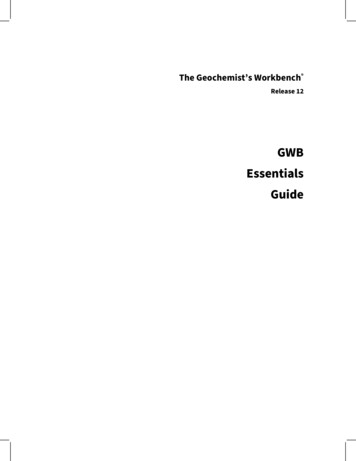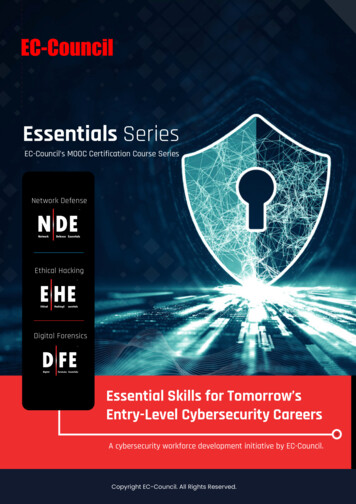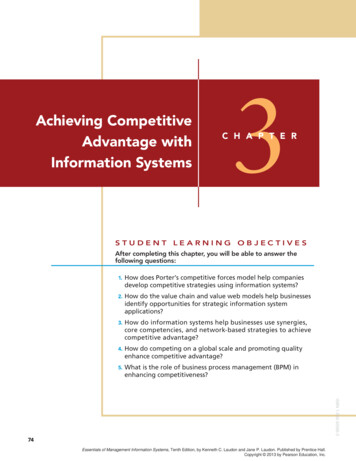
Transcription
Achieving CompetitiveAdvantage withInformation Systems3C H A P T E RSTUDENT LEARNING OBJECTIVESAfter completing this chapter, you will be able to answer thefollowing questions:1.How does Porter’s competitive forces model help companiesdevelop competitive strategies using information systems?2.How do the value chain and value web models help businessesidentify opportunities for strategic information systemapplications?3.How do information systems help businesses use synergies,core competencies, and network-based strategies to achievecompetitive advantage?4.How do competing on a global scale and promoting qualityenhance competitive advantage?5.What is the role of business process management (BPM) inenhancing competitiveness?ISBN 1-269-32566-374Essentials of Management Information Systems, Tenth Edition, by Kenneth C. Laudon and Jane P. Laudon. Published by Prentice Hall.Copyright 2013 by Pearson Education, Inc.
C HAPTER O UTLINEChapter-Opening Case: Verizon, AT&T, and Skype:Which Digital Strategy Will Prevail?3.1 Using Information Systems to AchieveCompetitive Advantage3.2 Competing on a Global Scale3.3 Competing on Quality and Design3.4 Competing on Business ProcessesBusiness Problem-Solving Case: Will Technology Savethe Publishing Industry?VERIZON, AT&T, AND SKYPE : WHICH DIGITAL STRATEGY WILL PREVAIL?Verizon and AT&T are the two largest telecommunications companies in the UnitedISBN 1-269-32566-3States. In addition to voice communication, customers use their networks to surf theInternet; send e-mail, text, and video messages; share photos; watch videos and highdefinition TV; and conduct videoconferences around the globe. All of these productsand services are digital.Competition in this industry is exceptionally intense and fast-changing. Bothcompanies have tried to prevail by refining their wireless, landline, and high-speedInternet networks and expanding the range of products, applications, and servicesavailable to customers. Wireless services are the most profitable, and smartphonecustomers are the most desirable of all because they typically pay higher monthlyrates for wireless data service plans. (Each iPhone owner pays an average of morethan 90 per month to AT&T.)For a number of years, Verizon tried to blunt competition by making heavytechnology investments in both its landline and wireless networks. Its wirelessnetwork was considered the most far-reaching and reliable in the United States.AT&T took a different path, partnering with other companies to capitalize on their Jose Luis Gutierrez, 2011, iStockPhoto LP.75Essentials of Management Information Systems, Tenth Edition, by Kenneth C. Laudon and Jane P. Laudon. Published by Prentice Hall.Copyright 2013 by Pearson Education, Inc.
76Part I: Information Systems in the Digital Agetechnology innovations. The company contracted with Apple Computer to be the exclusivenetwork for its iPhone. The iPhone’s streamlined design, touch screen, exclusive accessto the Apple iTunes music service, and 500,000 downloadable applications made it aninstant hit. Since its debut in 2007, the iPhone was AT&T’s primary growth engine.Now that’s all changing. In February 2011, Verizon was allowed to sell a version ofthe Apple iPhone that worked on its wireless network. Verizon further hedged its bets byoffering leading-edge smartphones based on Google’s highly-popular Android operatingsystem. AT&T countered in March 2011 by announcing its intention to buy T-Mobile USA, adeal that would make it the largest wireless carrier in the United States. The newly combinedcompany, combining AT&T’s 95.5 million wireless subscribers with T-Mobile’s 33.7 millionsubscribers, would account for 42 percent of all US wireless subscribers. (Verizon hasroughly 31 percent.)And it looks like the competitive balance is about to shift again. In May 2011,Microsoft acquired Skype, a service that allows users to make voice and video calls overthe Internet for free or for a very low cost. Skype’s smartphone app allows mobile usersto avoid paying higher fees to wireless carriers. Microsoft will be able to incorporateSkype into its other products, such as its Office productivity programs, Xbox videogame system, and Windows Phone 7 mobile operating system, enabling its users to beseamlessly connected at work and at home.Industry analysts predict that the majority of consumers will eventually move fromlandline telephones or from paying for mobile phone calls by the minute, to communicatingover the Internet using services like Skype. People won’t need to spend so much on mobilephones or land lines to make video calls. This will eat into the profits of Verizon and AT&T,which have been able to charge premium rates for their digital communication services.Sources: Nick Wingfield, “Microsoft Dials Up Change” Wall Street Journal, May 11, 2011; Jenna Wortham,“With Android Phones, Verizon Is in Position to Gain Lost Ground,” New York Times, January 6, 2011, and "As Verizon’sIPhone Sales Begin, Gauging the Effects on AT&T,” New York Times, February 9, 2011; Andrew Ross Sorkin, Michael J.De La Merced, and Jenna Wortham, “AT&T to Buy T-Mobile USA For 39 Million,” New York Times, March 20, 2011;Nick Bilton, "Skype, Even for 8.5 Billion, Could Be a Deal,” New York Times, May 10, 2011; and Roger Cheng, “ForTelecom Firms, Smartphones Rule,” Wall Street Journal, July 19, 2010.Essentials of Management Information Systems, Tenth Edition, by Kenneth C. Laudon and Jane P. Laudon. Published by Prentice Hall.Copyright 2013 by Pearson Education, Inc.ISBN 1-269-32566-3The story of Verizon, AT&T, and Skype illustrates some of the ways that information systemshelp businesses compete—and also the challenges of sustaining a competitive advantage.The telecommunications industry in which these companies operate is extremely crowdedand competitive, with telecommunications companies vying with cable companies, upstartssuch as Skype, and each other to provide a wide array of digital services as well as voicetransmission. To meet the challenges of surviving and prospering in this environment,Verizon and AT&T focused on different competitive strategies using information technology.The chapter-opening diagram calls attention to important points raised by this caseand this chapter. Both companies identified opportunities to use information technology tooffer new products and services. AT&T offered enhanced wireless services for the iPhone,while Verizon initially focused on high-capacity, high-quality network services. AT&T’sstrategy initially emphasized keeping costs low while capitalizing on innovations from othertechnology vendors. Verizon’s strategy involved high up-front costs to build a high-capacitynetwork infrastructure, and it also focused on providing a high level of network reliabilityand customer service.This case study clearly shows how difficult it is to sustain a competitive advantage.Exclusive rights to use the highly popular iPhone on its network brought AT&T millionsof new customers and enhanced its competitive position. But this competitive advantagehas diminished now that Verizon offers a version of the iPhone as well as popular Androidsmartphones. Acquiring T-Mobile would enable AT&T to shift its strategy to emphasizenetwork heft and breadth of coverage. Competition from Skype, which will affect wirelessservice pricing, may also tilt the competitive balance among the various wireless carriers.
Chapter 3: Achieving Competitive Advantage with Information Systems3.1 Using Information Systems to Achieve CompetitiveAdvantageIn almost every industry you examine, you will find that some firms do better than mostothers. There’s almost always a standout firm. In the automotive industry, Toyota isconsidered a superior performer. In pure online retail, Amazon is the leader; in offlineretail Walmart, the largest retailer on earth, is the leader. In online music, Apple’s iTunesis considered the leader with more than 75 percent of the downloaded music market, and inthe related industry of digital music players, the iPod is the leader. In Web search, Google isconsidered the leader.Firms that “do better” than others are said to have a competitive advantage over others:They either have access to special resources that others do not, or they are able to usecommonly available resources more efficiently—usually because of superior knowledgeand information assets. In any event, they do better in terms of revenue growth, profitability,or productivity growth (efficiency), all of which ultimately in the long run translate intohigher stock market valuations than their competitors.But why do some firms do better than others and how do they achieve competitiveadvantage? How can you analyze a business and identify its strategic advantages? How canyou develop a strategic advantage for your own business? And how do information systemscontribute to strategic advantages? One answer to these questions is Michael Porter’scompetitive forces model.ISBN 1-269-32566-3PORTER’S COMPETITIVE FORCES MODELArguably, the most widely used model for understanding competitive advantage is MichaelPorter’s competitive forces model (see Figure 3.1). This model provides a general view ofthe firm, its competitors, and the firm’s environment. Recall in Chapter 2 we described theimportance of a firm’s environment and the dependence of firms on environments. Porter’smodel is all about the firm’s general business environment. In this model, five competitiveforces shape the fate of the firm.Essentials of Management Information Systems, Tenth Edition, by Kenneth C. Laudon and Jane P. Laudon. Published by Prentice Hall.Copyright 2013 by Pearson Education, Inc.77
78Part I: Information Systems in the Digital AgeFigure 3.1Porter’sCompetitive ForcesModelIn Porter’s competitiveforces model, thestrategic position of thefirm and its strategiesare determined not onlyby competition withits traditional directcompetitors but alsoby four forces in theindustry’s environment:new market entrants,substitute products,customers, andsuppliers.Traditional CompetitorsAll firms share market space with other competitors who are continuously devising new,more efficient ways to produce by introducing new products and services, and attemptingto attract customers by developing their brands and imposing switching costs on theircustomers.New Market EntrantsIn a free economy with mobile labor and financial resources, new companies are alwaysentering the marketplace. In some industries, there are very low barriers to entry,whereas in other industries, entry is very difficult. For instance, it is fairly easy to starta pizza business or just about any small retail business, but it is much more expensiveand difficult to enter the computer chip business, which has very high capital costs andrequires significant expertise and knowledge that is hard to obtain. New companies haveseveral possible advantages: They are not locked into old plants and equipment, they oftenhire younger workers who are less expensive and perhaps more innovative, they are notencumbered by old worn-out brand names, and they are “more hungry” (more highlymotivated) than traditional occupants of an industry. These advantages are also theirweakness: They depend on outside financing for new plants and equipment, which can beexpensive; they have a less-experienced workforce; and they have little brand recognition.Substitute Products and ServicesIn just about every industry, there are substitutes that your customers might use if yourprices become too high. New technologies create new substitutes all the time. Even oil hassubstitutes: Ethanol can substitute for gasoline in cars; vegetable oil for diesel fuel in trucks;and wind, solar, coal, and hydro power for industrial electricity generation. Likewise, Internettelephone service can substitute for traditional telephone service, and fiber-optic telephonelines to the home can substitute for cable TV lines. And, of course, an Internet music servicethat allows you to download music tracks to an iPod is a substitute for CD-based musicstores. The more substitute products and services in your industry, the less you can controlpricing and the lower your profit margins.Essentials of Management Information Systems, Tenth Edition, by Kenneth C. Laudon and Jane P. Laudon. Published by Prentice Hall.Copyright 2013 by Pearson Education, Inc.ISBN 1-269-32566-3CustomersA profitable company depends in large measure on its ability to attract and retain customers(while denying them to competitors), and charge high prices. The power of customers growsif they can easily switch to a competitor’s products and services, or if they can force a businessand its competitors to compete on price alone in a transparent marketplace where there is
Chapter 3: Achieving Competitive Advantage with Information Systemslittle product differentiation, and all prices are known instantly (such as on the Internet). Forinstance, in the used college textbook market on the Internet, students (customers) can findmultiple suppliers of just about any current college textbook. In this case, online customershave extraordinary power over used-book firms.SuppliersThe market power of suppliers can have a significant impact on firm profits, especiallywhen the firm cannot raise prices as fast as suppliers can. The more suppliers a firmhas, the greater control it can exercise over those suppliers in terms of price, quality,and delivery schedules. For instance, manufacturers of laptop PCs almost always havemultiple competing suppliers of key components, such as keyboards, hard drives, anddisplay screens.INFORMATION SYSTEM STRATEGIES FOR DEALING WITHCOMPETITIVE FORCESWhat is a firm to do when faced with all these competitive forces? And how can the firm useinformation systems to counteract some of these forces? How do you prevent substitutes andinhibit new market entrants? How do you become the most successful firm in an industry interms of profit and share price (two measures of success)?Basic Strategy 101: Align the IT with the Business ObjectivesThe basic principle of IT strategy for a business is to ensure the technology serves thebusiness, and not the other way around. The research on IT and business performance hasfound that (a) the more successfully a firm can align its IT with its business goals, the moreprofitable it will be, and (b) only about one-quarter of firms achieve alignment of IT withbusiness. About half of a business firm’s profits can be explained by alignment of IT withbusiness (Luftman, 2003; Henderson, et al., 1996).Most businesses get it wrong: IT takes on a life of its own and does not servemanagement and shareholder interests very well. Instead of business people taking anactive role in shaping IT to the enterprise, they ignore it, claim to not understand IT, andtolerate failure in the IT area as just a nuisance to work around. Such firms pay a heftyprice in poor performance. Successful firms and managers understand what IT can do andhow it works, take an active role in shaping its use, and measure its impact on revenuesand profits.So how do you as a manager achieve this alignment of IT with business? In the followingsections, we discuss some basic ways to do this, but here’s a summary: Identify your business strategy and goals. Break these strategic goals down into concrete activities and processes. Identify how you will measure progress towards the business goals (e.g. metrics). Ask yourself “How can information technology help me achieve progress towards ourbusiness goals and how it will improve our business processes and activities?” Measure actual performance. Let the numbers speak.ISBN 1-269-32566-3Let’s see how this works out in practice. There are four generic strategies, each of whichoften is enabled by using information technology and systems: low-cost leadership, productdifferentiation, focus on market niche, and strengthening customer and supplier intimacy.Low-Cost LeadershipUse information systems to achieve the lowest operational costs and the lowest prices. Theclassic example is Walmart. By keeping prices low and shelves well stocked using a legendaryinventory replenishment system, Walmart became the leading retail business in the UnitedStates. Walmart’s continuous replenishment system sends orders for new merchandisedirectly to suppliers as soon as consumers pay for their purchases at the cash register. Pointof-sale terminals record the bar code of each item passing the checkout counter and send apurchase transaction directly to a central computer at Walmart headquarters. The computerEssentials of Management Information Systems, Tenth Edition, by Kenneth C. Laudon and Jane P. Laudon. Published by Prentice Hall.Copyright 2013 by Pearson Education, Inc.79
80Part I: Information Systems in the Digital AgeSupermarkets andlarge retail stores suchas Walmart use salesdata captured at thecheckout counter todetermine which itemshave sold and need tobe reordered. Walmart’scontinuous replenishment system transmitsorders to restock directlyto its suppliers. Thesystem enables Walmartto keep costs low whilefine-tuning its merchandise to meet customerdemands. kali9, 2011, iStockPhoto LP.collects the orders from all Walmart stores and transmits them to suppliers. Suppliers canalso access Walmart’s sales and inventory data using Web technology.Because the system replenishes inventory with lightning speed, Walmart does not needto spend much money on maintaining large inventories of goods in its own warehouses.The system also enables Walmart to adjust purchases of store items to meet customerdemands. Competitors, such as Sears, have been spending 24.9 percent of sales onoverhead. By using systems to keep operating costs low, Walmart pays only 16.6 percentof sales revenue for overhead. (Operating costs average 20.7 percent of sales in the retailindustry.)Walmart’s continuous replenishment system is also an example of an efficient customerresponse system. An efficient customer response system directly links consumer behavior todistribution and production and supply chains. Walmart’s continuous replenishment systemprovides such an efficient customer response. Dell Computer Corporation’s assemble-toorder system, described in the following discussion, is another example of an efficientcustomer response system.Essentials of Management Information Systems, Tenth Edition, by Kenneth C. Laudon and Jane P. Laudon. Published by Prentice Hall.Copyright 2013 by Pearson Education, Inc.ISBN 1-269-32566-3Product DifferentiationUse information systems to enable new products and services, or greatly change the customerconvenience in using your existing products and services. For instance, Google continuouslyintroduces new and unique search services on its Web site, such as Google Maps. Applecreated iPod, a unique portable digital music player, plus a unique online Web music servicewhere songs can be purchased for .69 to 1.29 each. Apple has continued to innovate withits multimedia iPhone, iPad tablet computer, and iPod video player.Manufacturers and retailers are using information systems to create products andservices that are customized and personalized to fit the precise specifications of individualcustomers. For example, Nike sells customized sneakers through its Nike iD program onits Web site. Customers are able to select the type of shoe, colors, material, outsoles,and even a logo of up to eight characters. Nike transmits the orders via computers tospecially-equipped plants in China and Korea. The sneakers cost only 10 extra andtake about three weeks to reach the customer. This ability to offer individually tailored
Chapter 3: Achieving Competitive Advantage with Information SystemsAmazon: One-click shoppingAmazon holds a patent on one-click shopping that it licensesto other online retailersOnline music: Apple iPod and iTunesAn integrated handheld player backed up with an online libraryof over 10 million songsGolf club customization: PingCustomers can select from more than 1 million different golfclub options; a build-to-order system ships their customizedclubs within 48 hoursOnline person-to-person payment:PayPal.comEnables transfer of money between individual bank accountsand between bank accounts and credit card accounts81TABLE 3.1IS-Enabled NewProducts and ServicesProviding CompetitiveAdvantageproducts or services using the same production resources as mass production is calledmass customization.Table 3.1 lists a number of companies that have developed IS-based products andservices that other firms have found difficult to copy.ISBN 1-269-32566-3Focus on Market NicheUse information systems to enable a specific market focus, and serve this narrow targetmarket better than competitors. Information systems support this strategy by producingand analyzing data for finely tuned sales and marketing techniques. Information systemsenable companies to analyze customer buying patterns, tastes, and preferences closely sothat they efficiently pitch advertising and marketing campaigns to smaller and smallertarget markets.The data come from a range of sources—credit card transactions, demographic data,purchase data from checkout counter scanners at supermarkets and retail stores, anddata collected when people access and interact with Web sites. Sophisticated softwaretools find patterns in these large pools of data and infer rules from them that can beused to guide decision making. Analysis of such data drives one-to-one marketing wherepersonal messages can be created based on individualized preferences. For example,Hilton Hotels’ OnQ system analyzes detailed data collected on active guests in all ofits properties to determine the preferences of each guest and each guest’s profitability.Hilton uses this information to give its most profitable customers additional privileges,such as late checkouts. Contemporary customer relationship management (CRM) systemsfeature analytical capabilities for this type of intensive data analysis (see Chapters 2and 8).Strengthen Customer and Supplier IntimacyUse information systems to tighten linkages with suppliers and develop intimacy withcustomers. Toyota, Ford, and other automobile manufacturers have information systemsthat give their suppliers direct access to their production schedules, enabling suppliersto decide how and when to ship supplies to the plants where cars are assembled. Thisallows suppliers more lead time in producing goods. On the customer side, Amazon.comkeeps track of user preferences for book and CD purchases, and can recommend titlespurchased by others to its customers. Strong linkages to customers and suppliers increaseswitching costs (the cost of switching from one product or service to competitor) andloyalty to your firm.Table 3.2 summarizes the competitive strategies we have just described. Somecompanies focus on one of these strategies, but you will often see firms pursuing several ofthem simultaneously. Starbucks, discussed in the Interactive Session on Technology, is anexample.Essentials of Management Information Systems, Tenth Edition, by Kenneth C. Laudon and Jane P. Laudon. Published by Prentice Hall.Copyright 2013 by Pearson Education, Inc.
82Part I: Information Systems in the Digital AgeINTERACTIVE SESSION: TECHNOLOGYTechnology Helps Starbucks Find New Ways to Competeoffered in each store. A majority of these customersalso use mobile devices to connect to the in-storeWi-Fi networks. Recognizing this, Starbucks launchedwhat it calls the “Starbucks Digital Network”, a portaldesigned specifically for mobile devices as opposed totraditional Web browsers. The site is optimized for allmajor smartphone operating systems (iOS, Android,and BlackBerry), and responds to the multi-touchcapability of devices like the iPad.The Starbucks Digital Network site was developedin partnership with Yahoo and functions as a contentportal. Starbucks customers using the site will receivefree Wall Street Journal access, select free iTunesdownloads, and a wide variety of other content.The site will integrate with Foursquare, a locationbased social networking site for mobile devices. Thisarrangement will allow users to check in and receiveaward points using Starbucks’ site. Because Starbuckshas the most Foursquare check-ins of any company todate, this feature has been popular with customers.Rather than serve ads on the site, Starbucks hasopted to offer the site free of advertising, hopingthat striking deals with content providers will makeit a profitable venture. Even if the Starbucks DigitalNetwork is not highly profitable, analysts suggest thatthe site is an effective way for Starbucks to improveits relationship with its most valuable customers and acreative use of the mobile digital platform to enhancecustomer satisfaction.In addition to revamping their business to betterserve the needs of their mobile users, Starbucks hasmade a concerted effort to become more efficient,reduce waste, and use the time saved to provide bettercustomer service. Starbucks set out to streamline thebusiness processes used in each of its stores so thatbaristas do not need to bend down to scoop coffee,cutting down on idle time while waiting for coffee todrain, and finding ways to reduce the amount of timeeach employee spends making a drink. Starbuckscreated a 10-person “lean team” whose job is to travelthe country visiting franchises and coaching them inlean techniques made famous by automaker Toyota’sproduction system.Store labor costs Starbucks about 2.5 billion,amounting to 24 percent of its annual revenue. IfStarbucks is able to reduce the time each employeespends making a drink, the company can make moredrinks with the same number of workers or withfewer workers. Alternatively, Starbucks could use thistime savings to give baristas more time to interactwith customers and hopefully improve the Starbucksexperience.Essentials of Management Information Systems, Tenth Edition, by Kenneth C. Laudon and Jane P. Laudon. Published by Prentice Hall.Copyright 2013 by Pearson Education, Inc.ISBN 1-269-32566-3Starbucks is the world’s largest specialty coffeeretailer, with more than 16,850 coffee shops in about40 countries. For years, Starbucks has continued togrow throughout the United States and internationally,opening franchises at an impressive rate. From 2002to 2007 alone, the company tripled the number ofstores it operated worldwide. Starbucks offers a uniqueexperience: high-end specialty coffees and beverages,friendly and knowledgeable servers, and customerfriendly coffee shops. This was a winning formula formany years and enabled Starbucks to charge premiumprices.During the economic downturn beginning in2008 profits plunged. Customers complained that thecompany had lost its hip, local feel and had becomemore like a fast-food chain. Many coffee drinkers wentin search of cheaper alternatives from McDonald’s andDunkin’ Donuts for their coffee fixes. Starbucks stocklost over 50 percent by the end of 2008. Major changeswere in order.Starbucks used the opportunity to overhaulits business using several different strategiessimultaneously. First, the company has revamped itsin-store technology and sought to integrate its businessprocesses with wireless technology and the mobiledigital platform. Also, rather than copy the practicesof competitors, Starbucks pursued a more aggressiveproduct differentiation strategy, intended to emphasizethe high quality of its beverages and efficient andhelpful customer service. At the same time, however,Starbucks also focused on becoming ‘lean’, like manyof its competitors, eliminating inefficiency whereverpossible.When Starbucks set out to improve its customerexperience, it found that more than a third of itscustomers are active users of smartphones. Thecompany set out to implement several features andimprovements that would appeal to this segmentof its customer base. First, Starbucks implementeda technology that allows customers to pay usinga smartphone app. The app is integrated withthe Starbucks Card system, which allows regularcustomers to pay with a pre-paid and rechargeablecard at any Starbucks branch. When customers makea purchase using the app, a cashier scans a bar codedisplayed on the phone, and the resulting sale ischarged to the customer’s Starbucks Card account.Customers report that paying using this app, availablefor all major smartphone operating systems, is muchfaster than traditional forms of payment.Many of Starbucks’ most loyal customers regularlyspend time using the free Wi-Fi wireless network
Chapter 3: Achieving Competitive Advantage with Information Systemsoffering price-reduced specials, such as a breakfastsandwich and a drink for 3.95. Cost reductions fromprocedural changes made it possible for Starbucks tooffer these lower prices.Major fast-food chains already used thesetechniques. While some baristas have resisted thechanges, and analysts were skeptical that the changeswould take hold, Starbucks attributes much of its recentuptick in profits to its efforts to go lean. StarbucksCEO Howard Schultz said that “the majority of costreductions we’ve achieved come from a new way ofoperating and serving our customers”, and also addedthat the time and money saved was also allowingthe company to improve its customer engagement.By 2011, Starbucks had returned to profitability andcontinuing growth, with plans to open 500 new stores,in large part because of the success of each thesechanges.Wireless technology enhanced Starbucks’business process simplification effort. Starbucksdistrict managers use the in-store wireless networks torun store operations and to connect to the company’sprivate corporate network and systems. Starbucksdistrict managers were equipped with Wi-Fi enabledlaptops for this purpose. Before the in-store wirelessnetworks were implemented, a district manager whooversaw 10 stores had to visit each store, review itsoperations, develop
model is all about the firm’s general business environment. In this model, five competitive ISBN 1-269-32566-3 forces shape the fate of the firm. Essentials of Management Information Systems, Tenth Edition, by Kenneth
